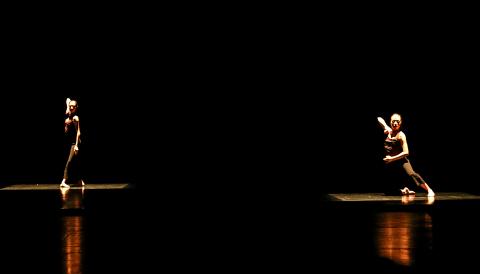Yilan County native Sheu Fang-yi (許芳宜) has long been one of Taiwan’s great exports, as well as an inspiration to many young Taiwanese dancers, but her appearances at home have been few and far between.
Since leaving the Martha Graham Dance Company in 2010, following a meteoric rise that took to principal dancer in 1999, just four years after joining the troupe, she has worked on stages — and with artists — from around the world.
That was part of the plan she had when she formed Fang-Yi Sheu & Artists (許芳宜&藝術家) in 2011 to serve as a platform for the exchange of ideas with artists from home and abroad.

Photo: CNA
While she has frequently come back to Taiwan to give workshops and speeches at schools — and perform at special events — it has been three years since she performed at the National Theater.
Her “2X2” program in November that year, which featured Sheu, Shanghai-born San Francisco Ballet principal Tan Yuanyuan (譚元元) and Ron “Prime Tyme” Myles in a program of dances by British choreographers Christopher Wheeldon and Russell Maliphant, Taiwanese-American choreographer Edwaard Liang (梁殷實) as well as Sheu, sold out two months in advance.
For her 2012 show at the theater, “Timeless,” she brought New York City Ballet dancers Wendy Whelan, Craig Hall and Tyler Angle, and British dancer/choreographer Akram Khan.

Photo: CNA
Sheu will be returning to Taiwan for five performances at the end of this month at the invitation of the National Theater Concert Hall as part of its 30th anniversary celebrations. There will be three shows at the National Theater, starting on Sept. 22, and two the next weekend in Kaoshiung. The three in Taipei are almost sold out.
At a news conference on June 1 at the theater, Sheu said “Salute” was conceived as a tribute to all the artists who love dance, as a salute from one dancer who is nearing the end of a career to those who came before her, and those who are following in her footsteps.
However, for all those reporters who keep asking when she is going to retire, Sheu said she has no plans to leave the stage as long as she can jump and move
“But who can say?” she said.
“Salute” features four works, two by Sheu and two by Maliphant.
One is a 12 minute solo that Maliphant created for himself in 1998 under a commission from the Dance Umbrella and is set to music by one of his favorite composers, Andy Cowton, though Cowton based the piece on work by Johann Sebastian Bach. He will be dancing the piece himself, a rare opportunity for dance lovers in Taiwan to see a master at work.
The second Maliphant piece is Two x Two, a duet he created in 2001 for his wife Dana Fouras, which is based on Two, an earlier piece he created for her.
Sheu performed Two x Two in the 2014 show with Tan and it was amazing.
Sheu’s Interweave stems from a “Creative Week” project at the Beijing National Theater in 2015, when she was invited to take part in a workshop with young dancers from China, South Korea and Taiwan. She returned for a second workshop the following year.
She sees the piece as an opportunity for different generations of dancers to work together. It features two South Koreans, two Chinese and two Taiwanese.
The fourth work, I Have My Heart (我心我行), is a piece that Sheu premiered the at National Center for the Performing Arts in Beijing in November last year.

When Taiwan was battered by storms this summer, the only crumb of comfort I could take was knowing that some advice I’d drafted several weeks earlier had been correct. Regarding the Southern Cross-Island Highway (南橫公路), a spectacular high-elevation route connecting Taiwan’s southwest with the country’s southeast, I’d written: “The precarious existence of this road cannot be overstated; those hoping to drive or ride all the way across should have a backup plan.” As this article was going to press, the middle section of the highway, between Meishankou (梅山口) in Kaohsiung and Siangyang (向陽) in Taitung County, was still closed to outsiders

President William Lai (賴清德) has championed Taiwan as an “AI Island” — an artificial intelligence (AI) hub powering the global tech economy. But without major shifts in talent, funding and strategic direction, this vision risks becoming a static fortress: indispensable, yet immobile and vulnerable. It’s time to reframe Taiwan’s ambition. Time to move from a resource-rich AI island to an AI Armada. Why change metaphors? Because choosing the right metaphor shapes both understanding and strategy. The “AI Island” frames our national ambition as a static fortress that, while valuable, is still vulnerable and reactive. Shifting our metaphor to an “AI Armada”

US President Donald Trump may have hoped for an impromptu talk with his old friend Kim Jong-un during a recent trip to Asia, but analysts say the increasingly emboldened North Korean despot had few good reasons to join the photo-op. Trump sent repeated overtures to Kim during his barnstorming tour of Asia, saying he was “100 percent” open to a meeting and even bucking decades of US policy by conceding that North Korea was “sort of a nuclear power.” But Pyongyang kept mum on the invitation, instead firing off missiles and sending its foreign minister to Russia and Belarus, with whom it

The older you get, and the more obsessed with your health, the more it feels as if life comes down to numbers: how many more years you can expect; your lean body mass; your percentage of visceral fat; how dense your bones are; how many kilos you can squat; how long you can deadhang; how often you still do it; your levels of LDL and HDL cholesterol; your resting heart rate; your overnight blood oxygen level; how quickly you can run; how many steps you do in a day; how many hours you sleep; how fast you are shrinking; how